Day 1 of a three day long weekend of Autumn Migration Tours today. It was cloudy all day but not too windy and, thankfully, the only shower fell while we were having lunch – and it was mercifully brief!
With lots of thrushes and finches arriving in over the last few days, we decided to start with a visit to check out the hedges at Warham Greens. As soon as we parked, we could hear several Blackbirds alarm calling.
As we walked up along the track, lots of birds came out of the hedges and flew on ahead of us. As well as lots more Blackbirds, there were plenty of Song Thrushes and a few Redwings too. They had probably all just arrived in from the continent and were taking a break to refuel on all the berries. We saw several tiny Goldcrests along here too – amazing to think that a bird so small can make it all the way across the North Sea. A Blackcap was typically elusive, climbing through the hedge before zipping across the track in front of us.
We stopped by a gate and looked across the grassy field beyond to some old barns. There were several Stock Doves on the roof. Here we saw a couple of Yellowhammers perched in the top of the hedge, with a Reed Bunting for company. A Chiffchaff flew across the track and dropped into the bushes at the base of a large sycamore. A Redwing perched up nicely for us in the top of the hedge.
Continuing on up the track, a little flock of Golden Plover flew over, calling. We could hear some rather noisy Grey Partridge out in one of the fields, but couldn’t see where they were through a thick hedge. A Sparrowhawk flew off across a field, disappearing into a hedge before emerging the other side a minute or so later, presumably after a quick rest.
As we were walking past a large oak tree, a sharp call caught our attention and we looked up to see a small bird flitting around in the leaves. It was a Yellow-browed Warbler. It was hard to see at first, high in the tree, but eventually we all got a good look at it, particularly as it dropped out of the tree and into the hedge, before working its way back up the track.
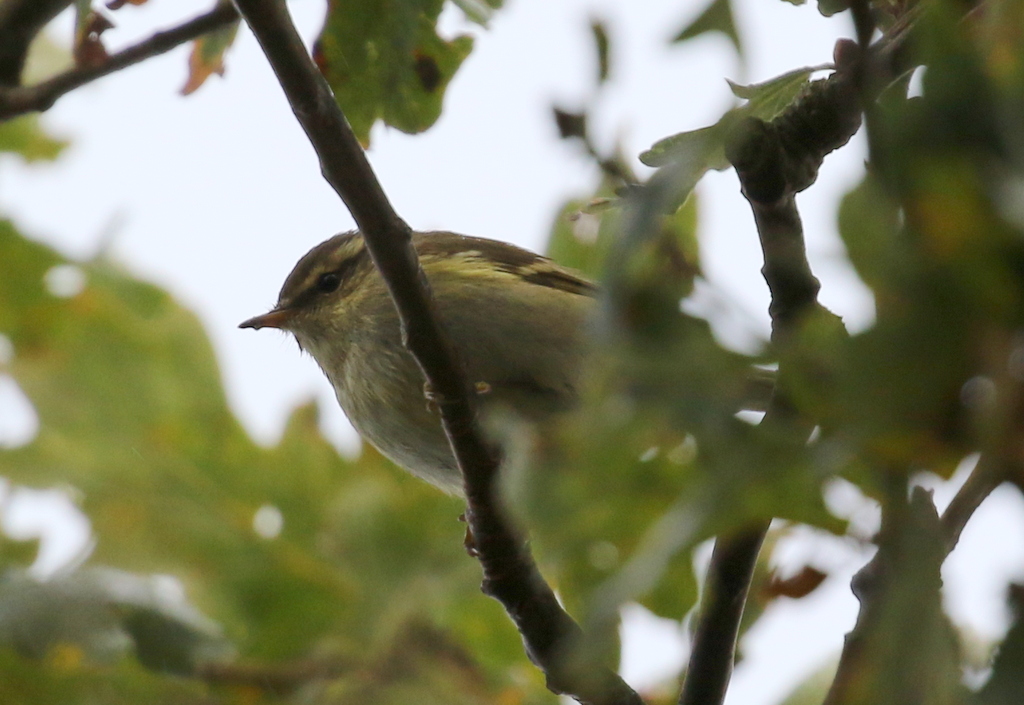 Yellow-browed Warbler – flitting around high in an oak tree
Yellow-browed Warbler – flitting around high in an oak tree
Yellow-browed Warblers breed in Siberia and winter mainly in Asia. They have become increasingly common in autumn here over the last 30 years, as the species has extended its breeding range westwards. Still, it a great bird to see and amazing to think that this small bird probably started its journey over at the Urals.
At the top of the track, we emerged out onto the coastal path and stopped to scan the saltmarsh. There were lots of Little Egrets scattered around, so common now it is amazing to think how rare they were only 20 years ago. A flock of Golden Plover down in the vegetation was very well camouflaged and hard to see until you looked through the scope. We could hear several Curlew calling from time to time, and eventually one landed close enough so we could get it in the scope.
There are always lots of Brent Geese out on the saltmarsh and today was no exception, with numbers having increased steadily even in the last few days, as more return for the winter. Most of the birds which come here at this time of year are Russian Dark-bellied Brents, but it is always worth checking through the groups carefully. Sure enough, as we looked through them, one bird instantly stood out. It was much darker, blackish, with a bright white flank patch and much more extensive white collar. It was a Black Brant.
 Black Brant – probably a returning individual, with the Dark-bellied Brents
Black Brant – probably a returning individual, with the Dark-bellied Brents
Black Brant is one of the other subspecies of Brent Goose. It breeds in NW North America and far eastern Siberia, wintering either side of the Pacific. It is a regular visitor here, with lost birds mixing with Dark-bellied Brent Geese in Russia and migrating to western Europe with them. Some of these birds then return winter after winter with the same group of Brents and there has been a Black Brant here in the winter for several years now. This is the first time we have seen it this winter, so it was a welcome surprise to find it here today.
Looking out beyond the saltmarsh, out towards the beach, we could see lots of waders on the sand flats in the distance. Through the scope, we could just make out a flock of Knot, accompanied by a few Grey Plover. In one of the tidal channels nearby, we picked out three ducks – Red-breasted Mergansers. But they were all very distant and hard to see much detail, even with a scope.
There were not so many flocks of thrushes coming in off the sea today, but there were still lots of birds moving. A steady stream of flocks of Starlings of various sizes flew west along the edge of the saltmarsh this morning. A flock of Lapwing flew over us. There were a few Chaffinches and Skylarks coasting too.
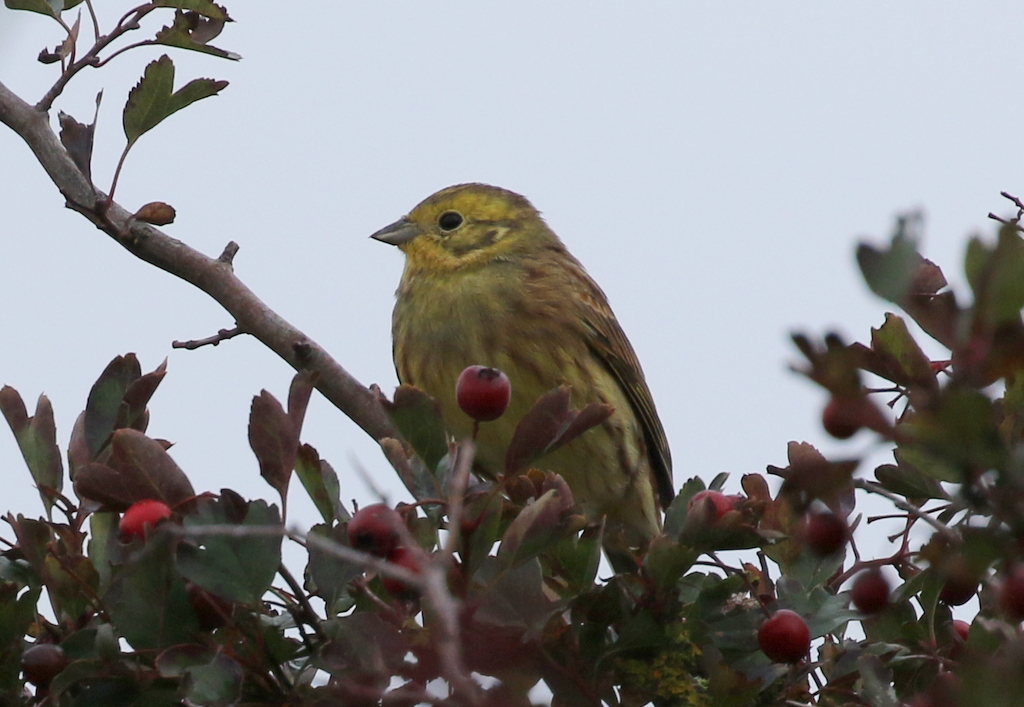 Yellowhammer – we saw several this morning in the hedges and down by the Pit
Yellowhammer – we saw several this morning in the hedges and down by the Pit
We had a quick look in the Pit, but it was fairly quiet today, suggesting there was perhaps not so much fresh in overnight last night. We did flush a few more Redwings from the bushes, one perching nicely in the top for us briefly, plus several Chaffinches and a couple of Yellowhammers. A large flock of Goldfinches kept coming & going, between the bushes round the Pit and the weedy vegetation on the edge of the saltmarsh. A male Stonechat put in a brief appearance down in the Suaeda too.
There were a few raptors out over the saltmarsh today. Three Marsh Harriers were quartering out along the edge of the beach pretty much all the time we were there. As we were leaving, we spotted a Red Kite flying lazily over the back of the saltmarsh and when we turned to head back, we noticed a second Red Kite circling over the field just behind us.
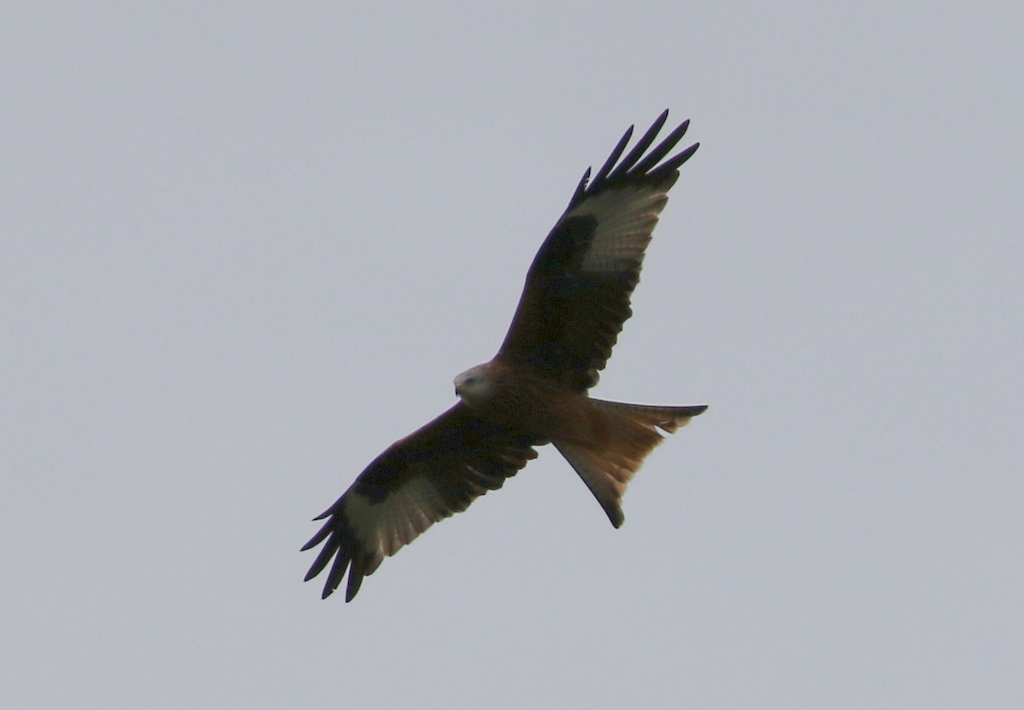 Red Kite – the second of two at Warham Greens today
Red Kite – the second of two at Warham Greens today
The walk back up the track was fairly uneventful – with fewer birds flushed from the hedgerows now, but still lots of Blackbirds, thrushes and a few Goldcrests. We were almost back to the car when we found a mixed flock of finches – mostly Chaffinches and Greenfinches but with at least one Brambling too. We heard the Brambling call, but unfortunately couldn’t see it in the thick vegetation.
We had a bit of time still before lunch, so we decided to head further east and have a look for the Cattle Egret at Stiffkey. As we drove past, we had a quick scan of the field, but the cows were lying down and there appeared to be no sign of the Cattle Egret with them. Being white, it normally sticks out like a sore thumb! We decided to have a quick look out at Stiffkey Fen, and then go back to the cows again afterwards.
As we walked down along the path beside the river, we could hear a Yellow-browed Warbler calling in the trees. It sounded as if it was making its way towards the near edge, so we walked back and could just see it up in the trees. It was very vocal, calling continually for a couple of minutes before going quiet. Our second Yellow-browed Warbler of the morning!
There were more birds along the path too. A Cetti’s Warbler shouted at us from deep in the brambles. A Yellowhammer called from the trees the other side of the river. We could hear Bullfinches calling plaintively and looked up to see a nice pink male fly past. We flushed more Blackbirds, Song Thrushes and Redwings from the brambles as we passed. Almost out to the seawall, a Chiffchaff called from the sallows.
Half way along, we stopped to look out at the Fen from the path. We could see lots of Ruff along the northern edge, below the reeds, and several smaller waders with them. Just as we got the scope onto them, they all took off. Several of the Ruff flew off inland, but two of the smaller waders landed on the mud in the middle of the Fen. One was a Dunlin but the other was a juvenile Little Stint, a nice surprise. We were just admiring the Little Stint through the scope when it took off and we didn’t see where it went.
Out on the seawall, we had another scan of the Fen, but we couldn’t see the Little Stint again, just a group of about ten Ruff where it had been. There was a nice selection of ducks on here, mostly Teal and Wigeon, but also quite a few Pintail, including some increasingly smart drakes as they emerge from eclipse plumage.
Looking out to Blakeney Harbour, the tide was out. A nice close Grey Plover was on the mud on the side of the channel, a juvenile, looking slightly golden-tinged on its upperparts. There were lots of Oystercatchers out on the sand in Blakeney Pit. As we scanned, we picked up a mixed flock of Bar-tailed Godwits and Sanderling which landed out on a sandbank with them. A big flock of Dunlin and Turnstone flew past.
There were also lots of Brent Geese and Wigeon out in the harbour. Several groups of gulls were loafing, Herring Gulls and big brutes of Great Black-backed Gulls. On the sand flats beyond the habour, we could see lots of seals hauled out, and through the scope we could see several Gannets diving into the sea beyond them.
As we turned to walk back, a Kingfisher was calling from down along the river channel, but we didn’t see it. The Yellow-browed Warbler showed itself again briefly on our way back past.
We continued on along the path and stopped down at the corner overlooking the grazing marshes. We were immediately informed that the Cattle Egret was back, but not in view. Thankfully we didn’t have to wait long before it walked out from behind the cows and we got a really good view of it through the scope. This Cattle Egret has been lingering here for some time now – perhaps it will stay until the cows are taken in for the winter? There were also two Grey Herons, lots of ducks, and several Ruff on the muddy flash here.
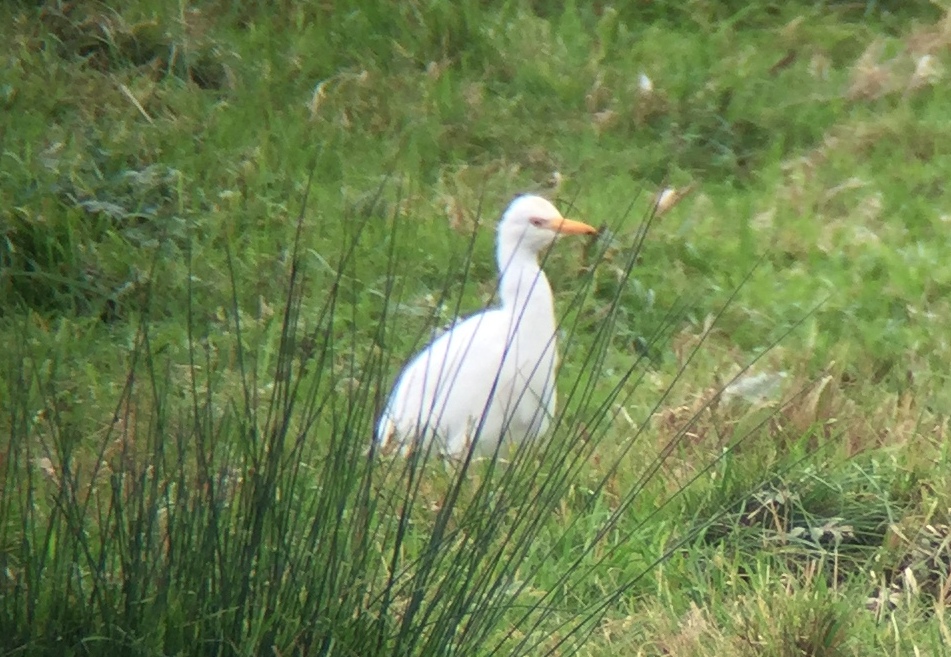 Cattle Egret – still lingering with the cows at Stiffkey
Cattle Egret – still lingering with the cows at Stiffkey
After we had all had a good look at the Cattle Egret, we headed back to the car and drove back to Holkham for a late lunch. While we were eating, the cloud thickened again and it start to rain. Thankfully it was just a shower and it quickly passed over, although it remained rather cool and cloudy.
After lunch, we headed into Holkham Park. The walk in through the trees was fairly quiet, perhaps with the weather clouding over and the breeze picking up they had retreated now. There are always lots of Fallow Deer in here and we saw several groups of females and a few bucks barking to defend their territories.
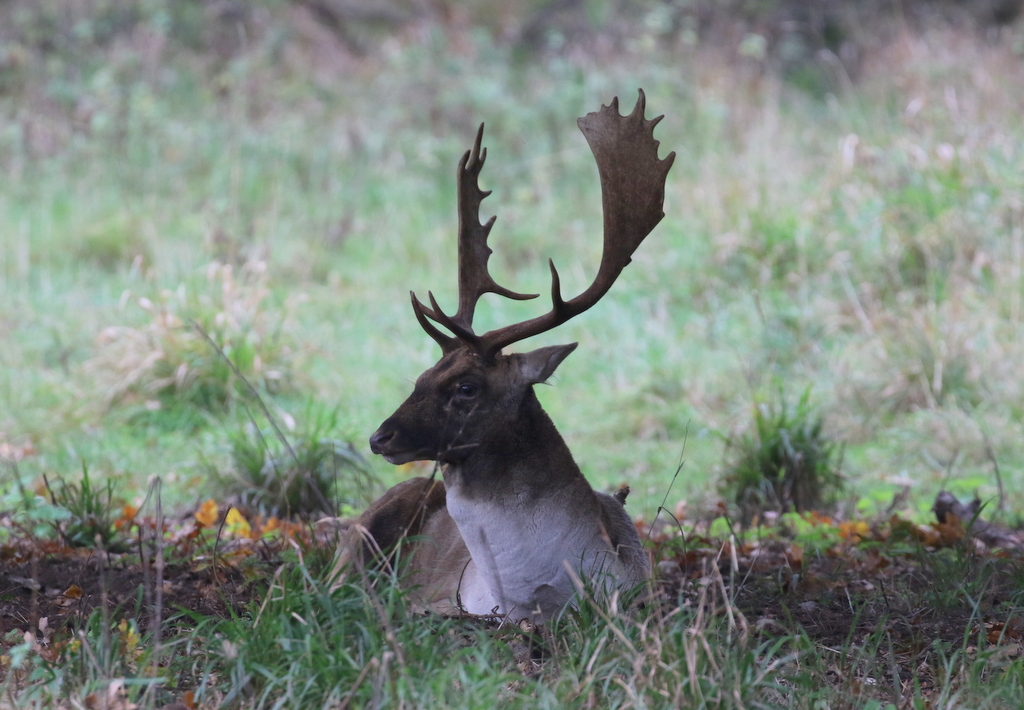 Fallow Deer – we saw lots in the Park again today
Fallow Deer – we saw lots in the Park again today
We made our way straight down to the lake, but there was no sign of the Osprey in any of its favourite trees. We couldn’t find it fishing at the north end of the lake either. We did find a nice variety of ducks on the lake – including Gadwall, Pochard and Tufted Duck – plus several Great Crested Grebes and Little Grebes.
Turning round, we walked down to the south end of the lake to see what we could find there. A quick scan revealed a juvenile Scaup in with a raft of Tufted Duck. It swam off out into the middle of the lake as we approached, but we had a good look at it through the scope, noting its pale surround to the bill and cheek spot.
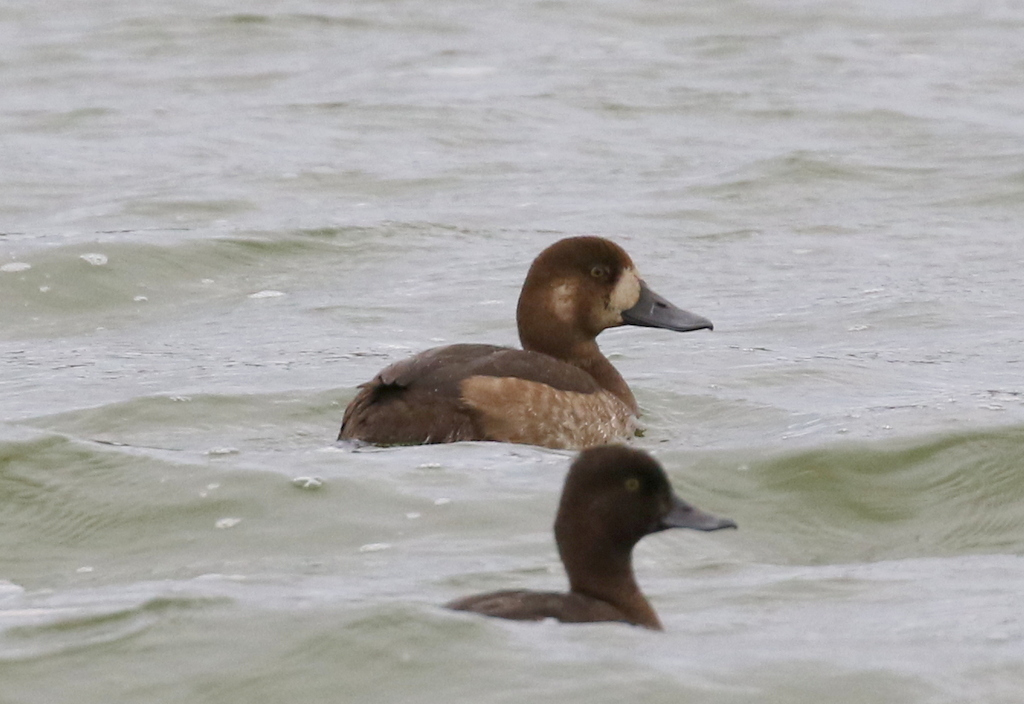 Scaup – a juvenile, with the Tufted Duck on the lake
Scaup – a juvenile, with the Tufted Duck on the lake
There were a couple of Egyptian Geese out on the lawn in front of the hall, but still no sign of the Osprey anywhere, so we set off back to the car. With everyone tired of walking, we decided to have a quick look out at the freshmarsh to finish the day. It turned out to be a good call. As soon as we pulled up, we could see a Great White Egret out on the edge of a ditch. By the time we had got out of the car, there were now two Great White Egrets. A second bird had appeared further back and was preening in the base of the sallows. Three species of egret in a day!
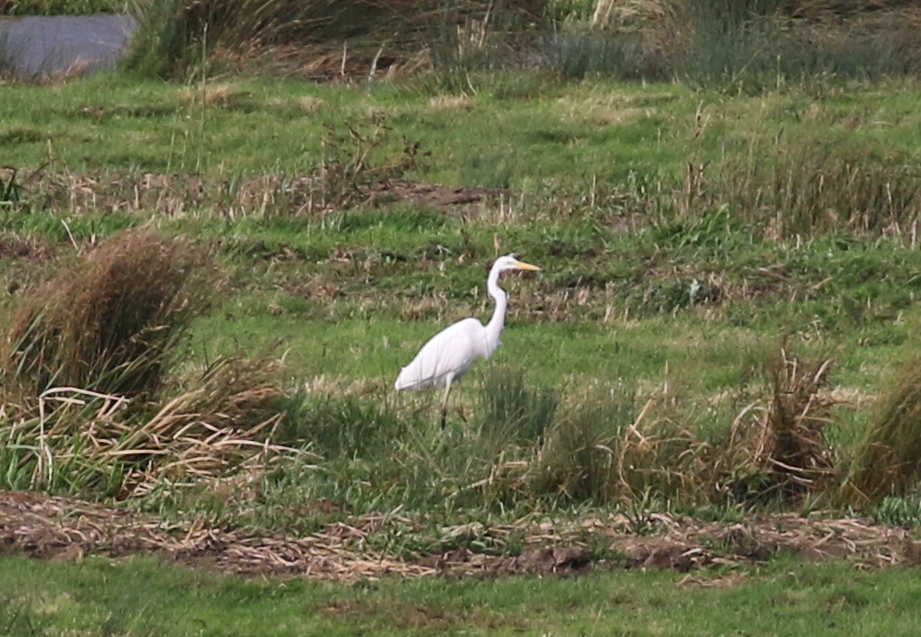 Great White Egret – one of two out on the freshmarsh late this afternoon
Great White Egret – one of two out on the freshmarsh late this afternoon
Scanning around the various pools, we picked up three Avocets on the edge of one of the more distant ones. There are not many Avocets around now, with most having left for the winter, so we stopped to look at them through the scope. As we did so, we noticed another small pale bird nearby. It was small and swimming in circles, in and out of the ducks nearby, a Grey Phalarope. A real bonus!
We had a good look at the Grey Phalarope before something flushed all the ducks and waders and it settled again on the water even further back. The geese down on the grass below us were almost entirely Greylags. Still, we scanned through them carefully to see if we could find anything else. We had almost given up when a family of three Russian White-fronted Geese walked out from behind the bushes, two adults with black belly bars and white fronts and a plainer juvenile. This is a regular wintering site for Russian White-fronts but these are the first we have seen here this winter. Nice to see them returning now.
It had been a really productive stop here, with lots of birds coming and going, but it was now time to call it a day and head for home. Here’s hoping for more of the same tomorrow!
















